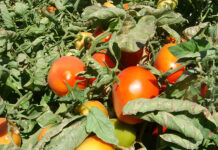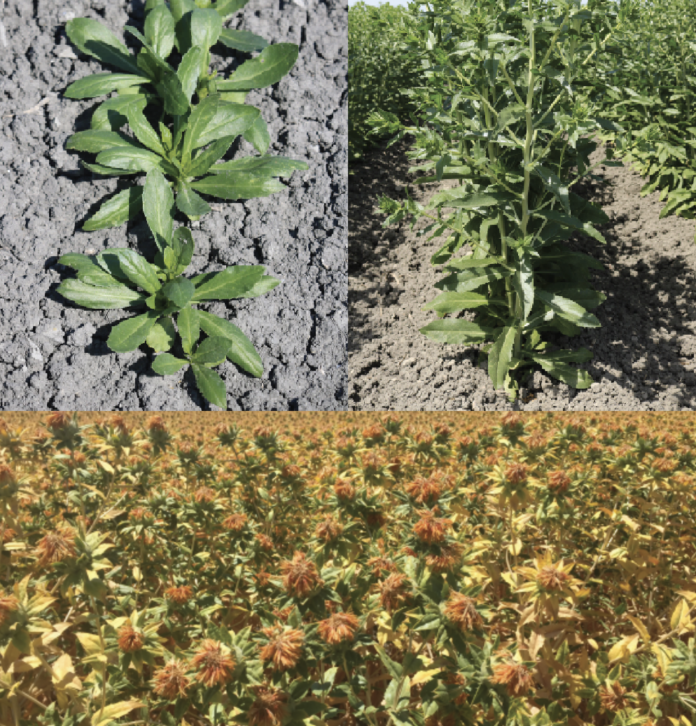
Safflower is an oilseed crop with several important uses beyond the valuable oil produced from the harvested seeds (Fig. 1). In the Tulare Lake Basin of the southern San Joaquin Valley in California, safflower is often grown in rotation with processing tomato and cotton. The benefits to the soil that safflower provides to the other crops comes largely from the exceptionally deep taproots that the plant grows, which are highly tolerant of saturated soil conditions. Safflower grown exclusively on residual water from a single preplant irrigation in the winter will draw down a perched water table, which cotton and tomato are sensitive to. Additionally, the taproots of the crop also create deep flow channels for improved water infiltration later in the year which greatly helps with any leaching efforts to remove accumulated salts from the root zone of cotton and tomato planted later.
Aside from the soil and water benefits to cotton and tomato, safflower also plays a key role in pest management in adjacent cotton and tomato fields. Insect pests, such as lygus bug and stink bugs, which are serious pests in tomato and cotton, and beet leafhopper, which transmits Beet Curly Top Virus to tomato, are all found in safflower. As safflower starts growing as early as February, it’s often the only green vegetative plants through April before cotton and tomatoes are planted. That means these insect pests show up on safflower first, and in that vein, safflower acts as an early indicator of the pressures these insects may pose for the upcoming cotton and tomato planted nearby. As cotton and tomato grow early in their seasons and become susceptible to damage from these pests, monitoring of these insect populations in safflower becomes very important to make decisions about areawide insect pest management. To that end, safflower acts as a sort of trap crop for these pests as growers can then treat safflower fields for these insects before they reach development stages and population levels that promote migration into tomato and cotton. This preventative monitoring and treatment in safflower improves pest management success in tomato and cotton by reducing the flow of the pests into these crops, which can then reduce the number of insecticide applications needed in cotton and tomato and preserve those uses for later in the season should they be needed.
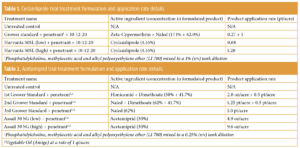
Insecticide Trials
Since 2018, we’ve conducted insecticide efficacy and crop safety trials in safflower for control of lygus, stink bugs and beet leafhopper. We compared how well these new insecticides controlled these pests and observed the safflower plants for symptoms of damage from the new insecticides. The purpose of the trials was to generate enough data that is required by the California Department of Pesticide Regulation to show the insecticides meet the state’s standards for being registered for use in safflower. In our trials, we compared the new insecticides to plots in the field that had no insecticide treatment as well as plots treated with the local growers’ standard insecticide treatment.
The insecticides studied were cyclaniliprole (Harvanta 50 SL) in two trials from 2018-19 (Table 1) and acetamiprid (Assail 30 SG) in two trials both in 2020 (Table 2). In trials for both insecticides, the experimental plots were treated three times during the season following the grower’s standard retreatment intervals for their standard treatment. In some of the select data provided, you’ll see pest control patterns for lygus and beet leafhopper. We never observed enough stink bugs in any of the trials to make conclusions about how well these insecticides worked in safflower.
In the 2019 cyclaniliprole trial, we saw good efficacy against lygus nymphs, the juvenile stage of the insect. However, we didn’t observe obvious control with the new insecticide compared to the untreated control until two weeks after the second treatment and then throughout the evaluation period after the third treatment application (Fig. 2). The grower standard treatment during this same time performed better than the cyclaniliprole treatments in controlling lygus nymphs. We never observed any crop injury related to applications of the cyclaniliprole treatments. These observations together supported the registration of Harvanta 50 SL for use in safflower in California, meaning safflower growers can now use this product in the state.
In one of the 2020 acetamiprid trials, we saw good efficacy against beet leafhoppers. Control of beet leafhoppers was significantly better than the untreated control after each of the three treatments, but this usually lasted for only a week (Fig. 3). The acetamiprid performed similarly to or better than the grower standard control throughout the trial. We didn’t observe any crop injury effects from acetamiprid applications to safflower during the trial. These data are currently being evaluated for registration of Assail 30 SG in California to be used in safflower.
These new insecticides can provide valuable tools to safflower growers in California, not just for managing insect pests in safflower but also for managing pests that may migrate into neighboring cotton and tomato crops. The work done in these trials is supported by efforts put forward by local safflower growers and the pesticide manufacturers. The IR-4 project financially supports and coordinates the trials and product label registration efforts.
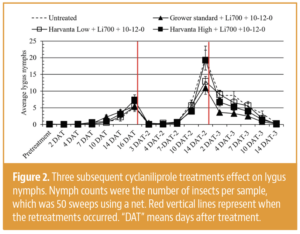
The IR-4 Project
Since 1963, the IR-4 project continues to serve the specialty crop industry by increasing pest management solutions for growers while securing healthy food safe for consumption.
IR-4 specialty crops include fruits, nuts, herbs and vegetables recommended for a healthy diet as well as flowers, trees and shrubs that enhance our environment. It’s no mystery in today’s world consumers demand high-quality produce and plants. Managing harmful insects, weeds and diseases are difficult tasks for today’s growers given current pest populations, exotic and invasive species, resistance management, regulatory restrictions, residue mitigation, organic food production and many other challenges. Access to integrated pest management (IPM) tools are essential for food security and human health.
The mission of IR-4 is to facilitate regulatory approval of sustainable pest management technology for specialty crops and specialty uses to promote public well-being. The label is the law, and IR-4 works in label expansion for the safe, legal and effective use of biological and conventional pesticides. On a national level, IR-4 works with producers, growers, stakeholders, academics and extension agents to identify pest management needs and potential solutions.
IR-4 stands for Interregional Research Project #4; a bit of a mouthful, but a relic of it’s past. Label expansion can be quite cost-prohibitive, with registration fees today reaching the six- and seven-figure level at times. Prior to 1950, pest control options like those registered in large acreage crops (wheat, corn, soybean, etc.) were not available to specialty crop growers due to these costs. Furthermore, minor use patterns on major crops left a deficit to grower needs. This dilemma was coined the “Minor Use Problem.” In the late 1950s, State Agricultural Experiment Station (SAES) directors, university extension agents and USDA recognized the need to develop processes for registering pesticides for use on specialty crops and minor uses on major crops. As a result, in 1964, an Interregional Research Project #4 titled, ‘Evaluation of Current Data and Needed Research to Determine Tolerance Limits of Chemicals for Minor Uses on Agricultural Products,’ was created. Now, if registrants go through IR-4, registration fees are waived and the necessary research is funded, provided the request comes from the public (growers, academics) and the use fits into an IPM strategy.
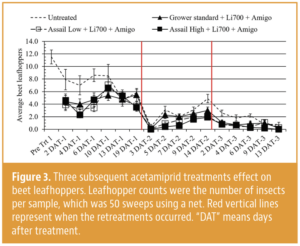
Today, the IR-4 Project operates as a unique partnership between USDA (both the National Institute of Food and Agriculture (NIFA) and the Agricultural Research Service (ARS)), SAES, the EPA, the plant protection materials industry, commodity groups and growers. In recent years, additional partnerships formed with USDA-Foreign Agricultural Service supporting international specialty crop export activities, Animal Plant Health Inspection Service working on selected invasive species, the Department of Defense’s Deployed Warfighter Protection Program providing regulatory support for public health pesticides, and CDFA.
IR-4 is constantly evolving to meet the needs of producers and consumers by providing tools for IPM and collaborating in global harmonization of residue levels. The Integrated Solutions Program focuses on research areas like pest problems without solutions, resistance management, residue mitigation and organic food production. The Biopesticide Regulatory Support Program furthers the development and registration of biopesticides by providing regulatory assistance to public-sector scientists and small businesses navigating the EPA registration process. The Environmental Horticulture Program focuses on invasive species and pollinator protection. International efforts include harmonizing crop groups and maximum residue levels to reduce trade barriers for U.S. producers.
Research requires funding; therefore, IR-4 is funded by USDA-NIFA and CDFA and receives in-kind contributions from SAES, U.S. EPA, the crop protection industry, Canada and commodity associations.
Headquartered at North Carolina State University, IR-4 has regional facilities at University of Florida, University of Maryland Eastern Shore, Michigan State University and UC Davis. There are also liaisons in every state working with local growers to identify safe and effective solutions for pest management. IR-4 research takes place at many land grant universities and USDA-ARS facilities across the country.
If you would like to get involved, please contact Kari Arnold, based in UC Davis, at (530) 574-9181 or klarnold@ucdavis.edu.











